Analysis of the Effect of Photo and Hydrodegradation on the Surface Morphology and Mechanical Properties of Composites Based on PLA and PHI Modified with Natural Particles
Abstract
:1. Introduction
2. Materials and Methods
2.1. Materials
2.2. Testing Methods
2.2.1. Morphology and Structure Characterizations
2.2.2. Contact Angle Measurement
2.2.3. Mechanical Tests
2.2.4. Photodegradation
2.2.5. Hydrodegradation
2.2.6. Low-Cyclic Fatigue Tests
3. Results and Discussion
3.1. Unexposed Samples
3.1.1. Morphological Study
3.1.2. Contact Angle
3.1.3. Tensile and Flexural Tests
3.1.4. Dynamic Tests
3.2. Exposed Samples
3.2.1. Surface Color
3.2.2. Water Absorption
3.2.3. Mechanical Test after Photo and Hydrodegradation
4. Conclusions
Author Contributions
Funding
Institutional Review Board Statement
Informed Consent Statement
Data Availability Statement
Acknowledgments
Conflicts of Interest
References
- Kahlert, S.; Bening, C.R. Plastics recycling after the global pandemic: Resurgence or regression? Resour. Conserv. Recycl. 2020, 160, 104948. [Google Scholar] [CrossRef]
- Ghosh, T.; Bhasney, S.M.; Katiyar, V. Blown films fabrication of poly lactic acid based biocomposites: Thermomechanical and migration studies. Mater. Today Commun. 2020, 22, 100737. [Google Scholar] [CrossRef]
- Dai, L.; Xi, X.; Li, X.; Li, W.; Du, Y.; Lv, Y.; Wang, W.; Ni, Y. Self-assembled all-polysaccharide hydrogel film for versatile paper-based food packaging. Carbohydr. Polym. 2021, 271, 118425. [Google Scholar] [CrossRef] [PubMed]
- Versino, F.; López, O.V.; García, M.A.; Versino, F.; García, M.A.; López, O.V. Green Biocomposites for Packaging Applications. In Biocomposite Materials; Springer: Singapore, 2021; pp. 1–30. [Google Scholar] [CrossRef]
- Battegazzore, D.; Abt, T.; Maspoch, M.L.; Frache, A. Multilayer cotton fabric bio-composites based on PLA and PHB copolymer for industrial load carrying applications. Compos. Part B Eng. 2019, 163, 761–768. [Google Scholar] [CrossRef]
- Hartley, K.; van Santen, R.; Kirchherr, J. Policies for transitioning towards a circular economy: Expectations from the European Union (EU). Resour. Conserv. Recycl. 2020, 155, 104634. [Google Scholar] [CrossRef]
- Kumar, R.; Ul Haq, M.I.; Raina, A.; Anand, A. Industrial applications of natural fibre-reinforced polymer composites—Challenges and opportunities. Environ. Chem. Lett. 2018, 12, 212–220. [Google Scholar] [CrossRef]
- Badia, J.D.; Kittikorn, T.; Strömberg, E.; Santonja-Blasco, L.; Martínez-Felipe, A.; Ribes-Greus, A.; Ek, M.; Karlsson, S. Water absorption and hydrothermal performance of PHBV/sisal biocomposites. Polym. Degrad. Stab. 2014, 108, 166–174. [Google Scholar] [CrossRef]
- Dietrich, K.; Dumont, M.J.; Del Rio, L.F.; Orsat, V. Producing PHAs in the bioeconomy—Towards a sustainable bioplastic. Sustain. Prod. Consum. 2017, 9, 58–70. [Google Scholar] [CrossRef]
- Gordobil, O.; Delucis, R.; Egüés, I.; Labidi, J. Kraft lignin as filler in PLA to improve ductility and thermal properties. Ind. Crops Prod. 2015, 72, 46–53. [Google Scholar] [CrossRef]
- Sarikaya, E.; Çallioğlu, H.; Demirel, H. Production of epoxy composites reinforced by different natural fibers and their mechanical properties. Compos. Part B Eng. 2019, 167, 461–466. [Google Scholar] [CrossRef]
- Restuccia, D.; Spizzirri, U.G.; Parisi, O.I.; Cirillo, G.; Curcio, M.; Iemma, F.; Puoci, F.; Vinci, G.; Picci, N. New EU regulation aspects and global market of active and intelligent packaging for food industry applications. Food Control 2010, 21, 1425–1435. [Google Scholar] [CrossRef]
- No 1935/2004 of 27 October 2004 on Materials and Articles Intended to Come Into Contact with Food and Repealing Directives 80/590/EEC and 89/109/EEC 2004; Commission Regulation (EU): Brussels, Belgium, 2004; pp. 4–17.
- Medina-Jaramillo, C.; Ochoa-Yepes, O.; Bernal, C.; Famá, L. Active and smart biodegradable packaging based on starch and natural extracts. Carbohydr. Polym. 2017, 176, 187–194. [Google Scholar] [CrossRef]
- Tichoniuk, M.; Radomska, N.; Cierpiszewski, R. The Application of Natural Dyes in Food Freshness Indicators Designed for Intelligent Packaging. Stud. Oeconomica Posnaniensia 2017, 5, 19–34. [Google Scholar] [CrossRef]
- Oksman, K.; Skrifvars, M.; Selin, J.F. Natural fibres as reinforcement in polylactic acid (PLA) composites. Compos. Sci. Technol. 2003, 63, 1317–1324. [Google Scholar] [CrossRef]
- Pratt, S.; Vandi, L.-J.; Gapes, D.; Werker, A.; Oehmen, A.; Laycock, B. Polyhydroxyalkanoate (PHA) Bioplastics from Organic Waste. In Biorefinery; Springer: Cham, Switzerland, 2019; pp. 615–638. [Google Scholar] [CrossRef]
- Noor Azammi, A.M.; Ilyas, R.A.; Sapuan, S.M.; Ibrahim, R.; Atikah, M.S.N.; Asrofi, M.; Atiqah, A. Characterization studies of biopolymeric matrix and cellulose fibres based composites related to functionalized fibre-matrix interface. In Interfaces in Particle and Fibre Reinforced Composites; Woodhead Publishing: Sawston, UK, 2020; pp. 29–93. [Google Scholar] [CrossRef]
- Koohestani, B.; Darban, A.K.; Mokhtari, P.; Yilmaz, E.; Darezereshki, E. Comparison of different natural fiber treatments: A literature review. Int. J. Environ. Sci. Technol. 2019, 16, 629–642. [Google Scholar] [CrossRef]
- Do Amaral Montanheiro, T.L.; Montagna, L.S.; Patrulea, V.; Jordan, O.; Borchard, G.; Ribas, R.G.; Campos, T.M.B.; Thim, G.P.; Lemes, A.P. Enhanced water uptake of PHBV scaffolds with functionalized cellulose nanocrystals. Polym. Test. 2019, 79, 106079. [Google Scholar] [CrossRef]
- Hassaini, L.; Kaci, M.; Benhamida, A.; Bruzaud, S.; Pillin, I.; Grohens, Y. The effects of PHBV-g-MA compatibilizer on morphology and properties of poly(3-hydroxybutyrate-Co-3-hydroxyvalerate)/olive husk flour composites. J. Adhes. Sci. Technol. 2016, 30, 2061–2080. [Google Scholar] [CrossRef]
- Mazur, K.; Singh, R.; Friedrich, R.P.; Genç, H.; Unterweger, H.; Sałasińska, K.; Bogucki, R.; Kuciel, S.; Cicha, I. The Effect of Antibacterial Particle Incorporation on the Mechanical Properties, Biodegradability, and Biocompatibility of PLA and PHBV Composites. Macromol. Mater. Eng. 2020, 305, 2000244. [Google Scholar] [CrossRef]
- Kong, L.; Li, F.; Wang, F.; Miao, Y.; Huang, X.; Zhu, H.; Lu, Y. In situ assembly of SiO2 nanodots/layered double hydroxide nanocomposite for the reinforcement of solution-polymerized butadiene styrene rubber/butadiene rubber. Compos. Sci. Technol. 2018, 158, 9–18. [Google Scholar] [CrossRef]
- Halász, K.; Csóka, L. Plasticized Biodegradable Poly(lactic acid) Based Composites Containing Cellulose in Micro- and Nanosize. J. Eng. 2013, 2013, 1–9. [Google Scholar] [CrossRef] [Green Version]
- Ly, B.C.K.; Dyer, E.B.; Feig, J.L.; Chien, A.L.; Del Bino, S. Research Techniques Made Simple: Cutaneous Colorimetry: A Reliable Technique for Objective Skin Color Measurement. J. Invest. Dermatol. 2020, 140, 3–12. [Google Scholar] [CrossRef] [PubMed] [Green Version]
- Jha, A.K.; Sit, N. Drying characteristics and kinetics of colour change and degradation of phytocomponents and antioxidant activity during convective drying of deseeded Terminalia chebula fruit. J. Food Meas. Charact. 2020, 14, 2067–2077. [Google Scholar] [CrossRef]
- Latos-Brozio, M.; Masek, A. The application of natural food colorants as indicator substances in intelligent biodegradable packaging materials. Food Chem. Toxicol. 2020, 135, 110975. [Google Scholar] [CrossRef]
- Carrascal, I.; Casado, J.A.; Polanco, J.A.; Gutirrez-Solana, F. Absorption and diffusion of humidity in fiberglass-reinforced polyamide. Polym. Compos. 2005, 26, 580–586. [Google Scholar] [CrossRef]
- Cairncross, R.A.; Becker, J.G.; Ramaswamy, S.; O’Connor, R. Moisture sorption, transport, and hydrolytic degradation in polylactide. Appl. Biochem. Biotechnol. 2006, 131, 774–785. [Google Scholar] [CrossRef]

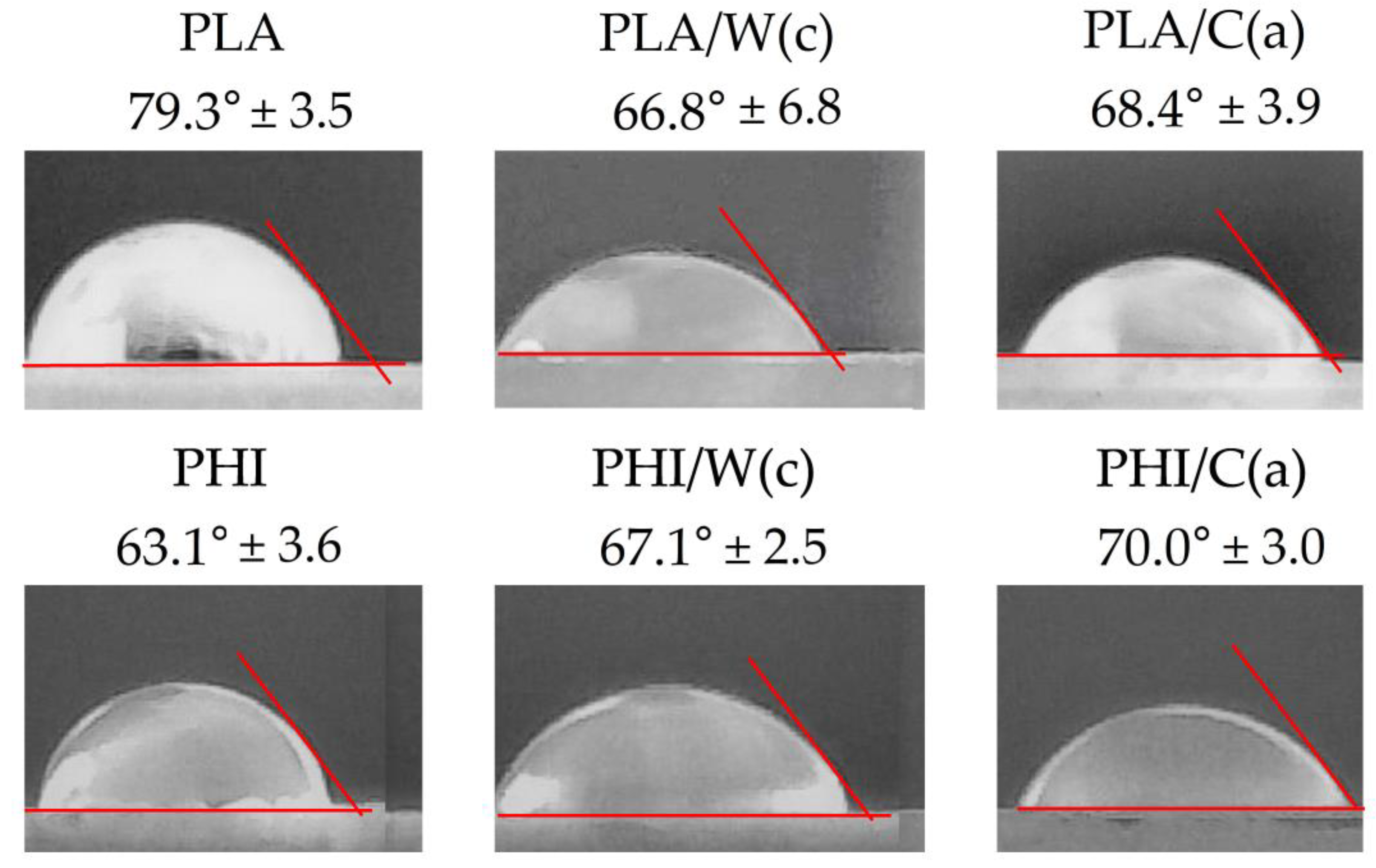
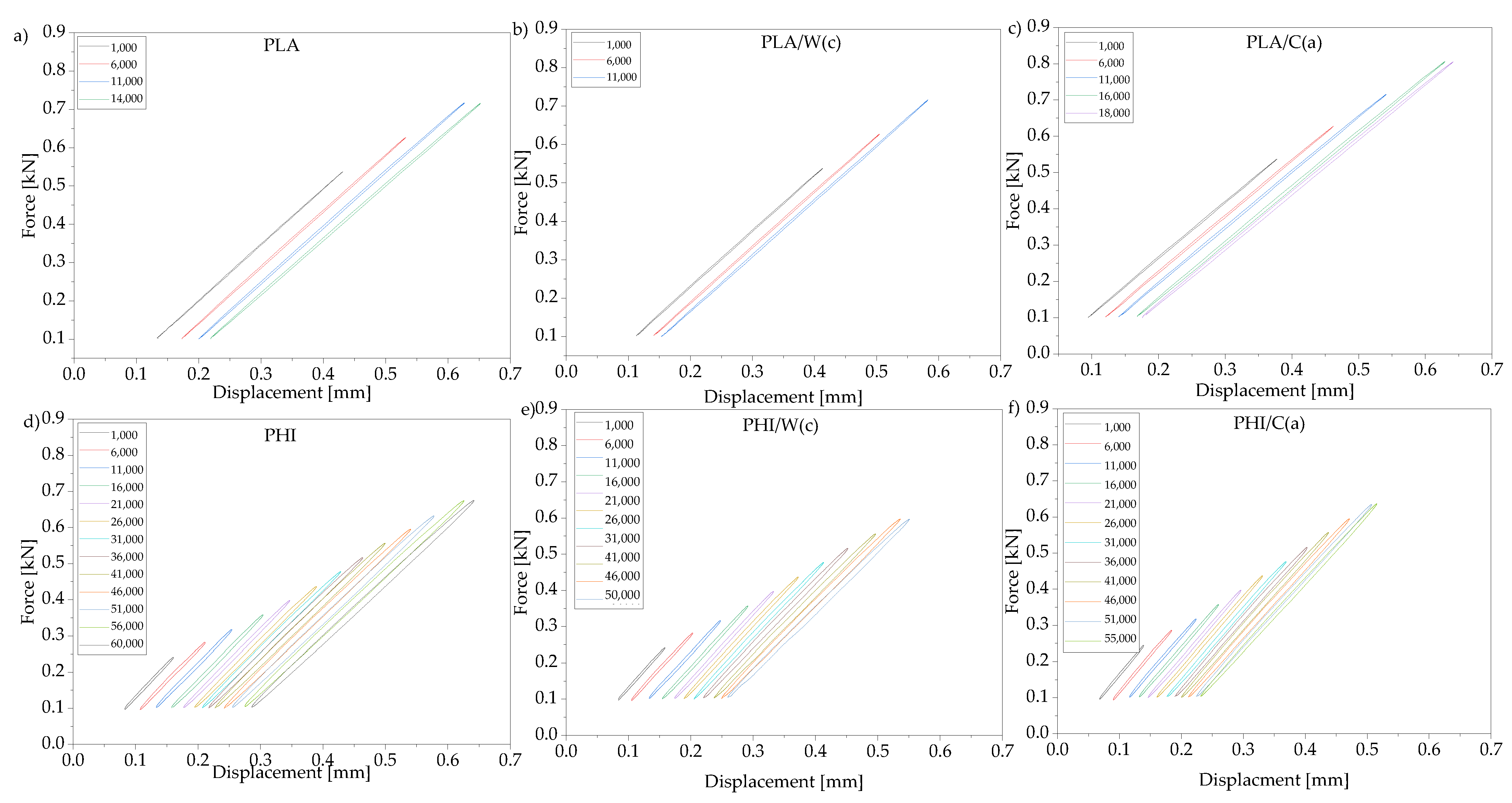
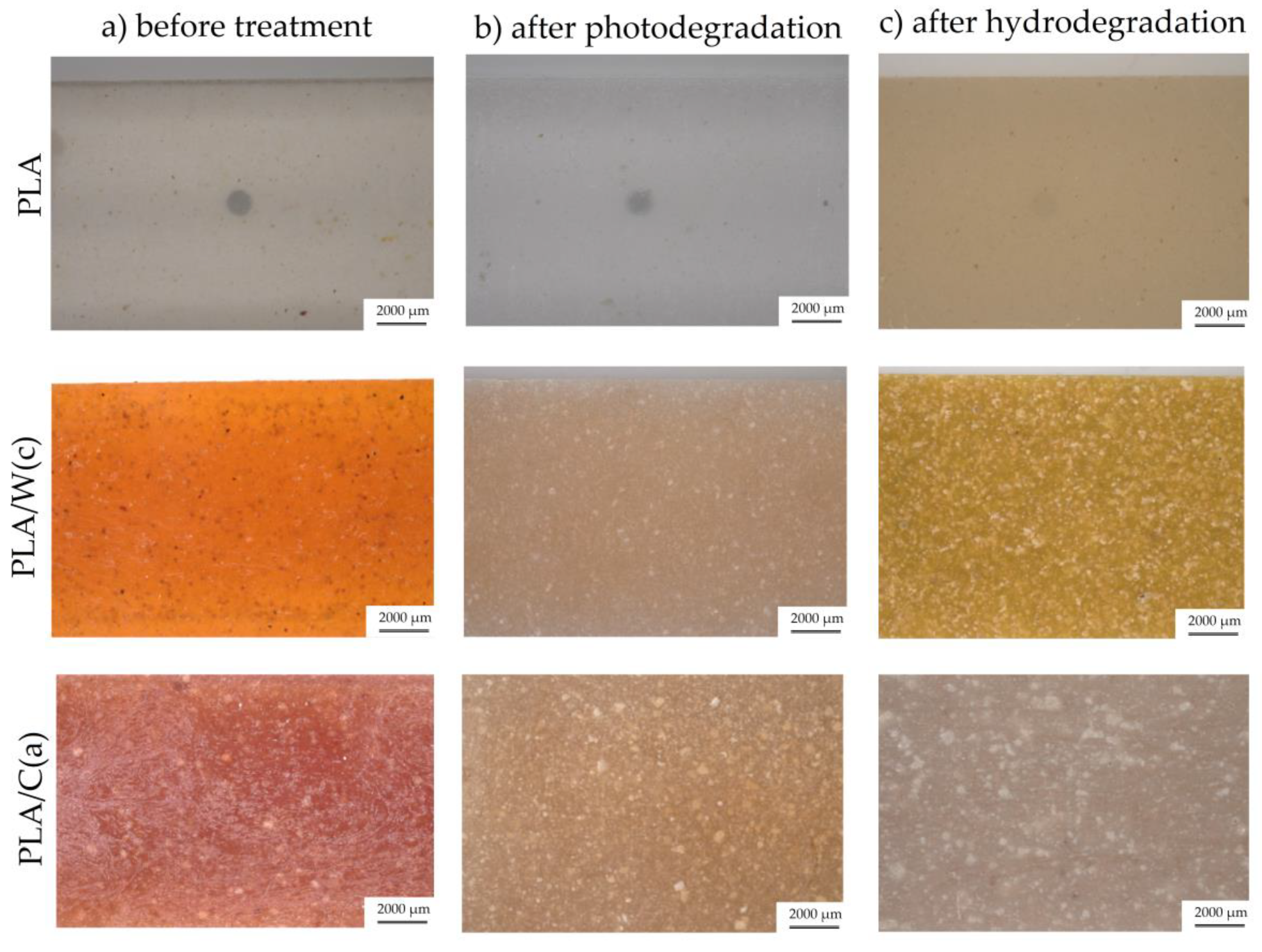
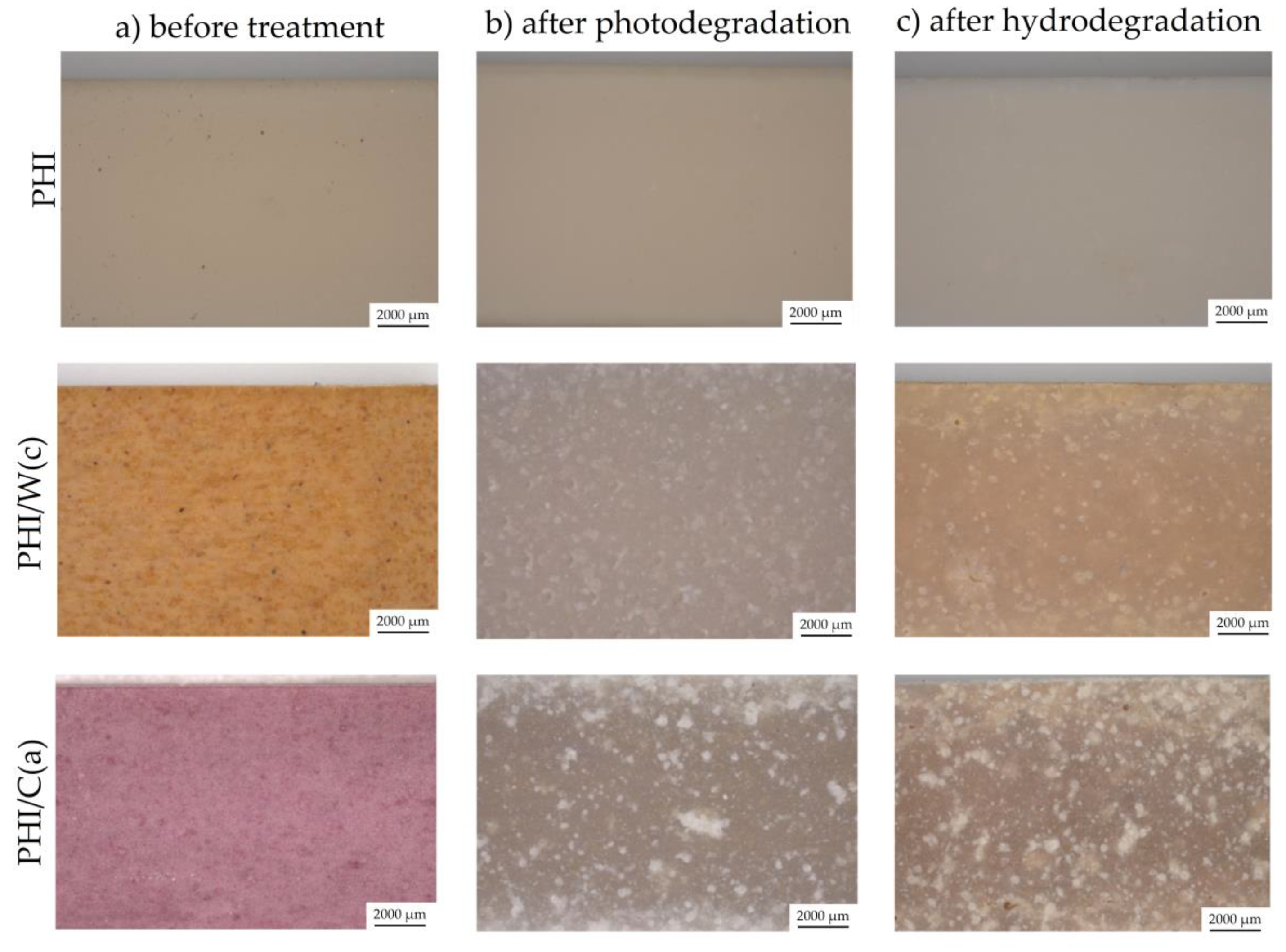
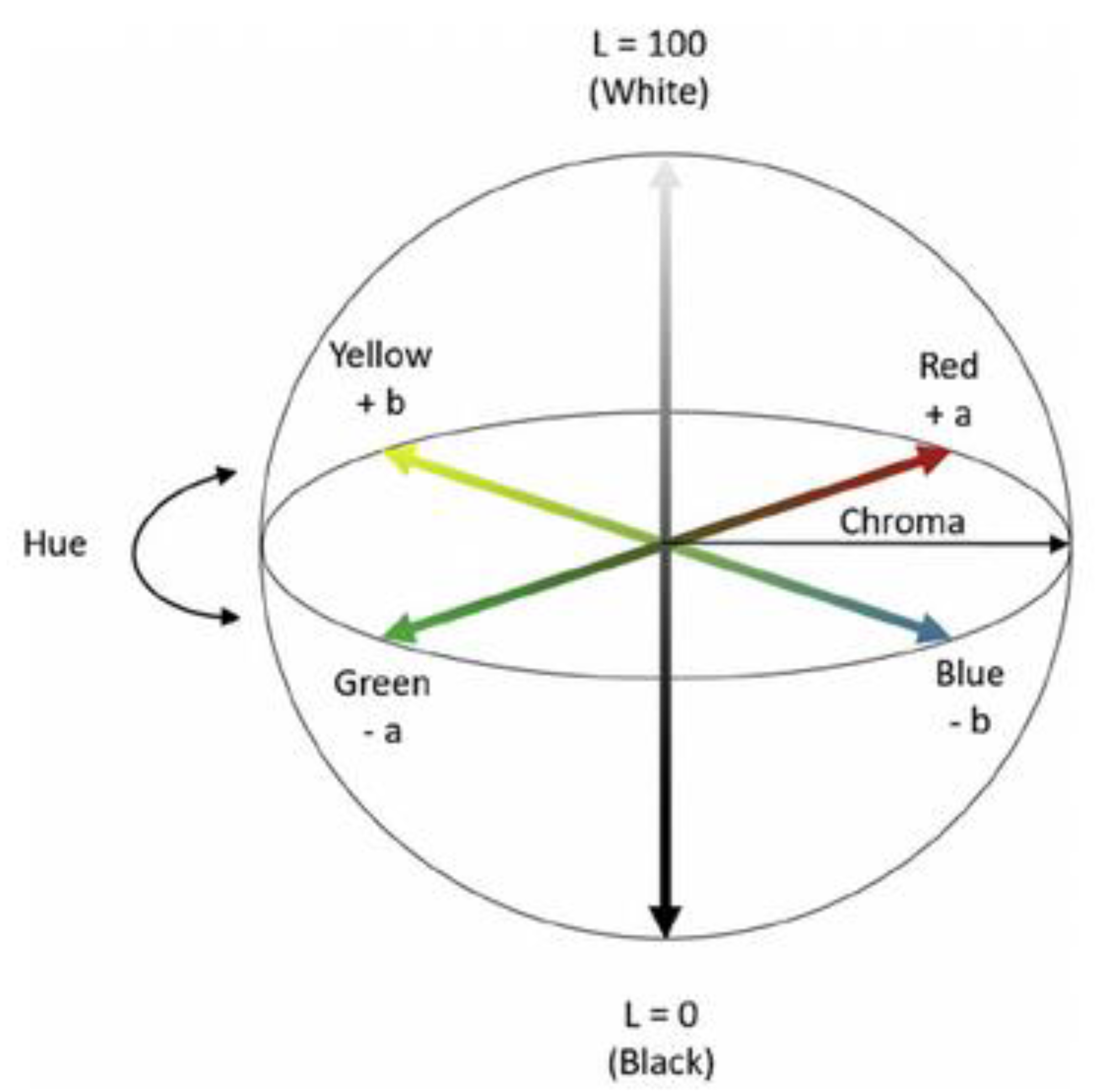
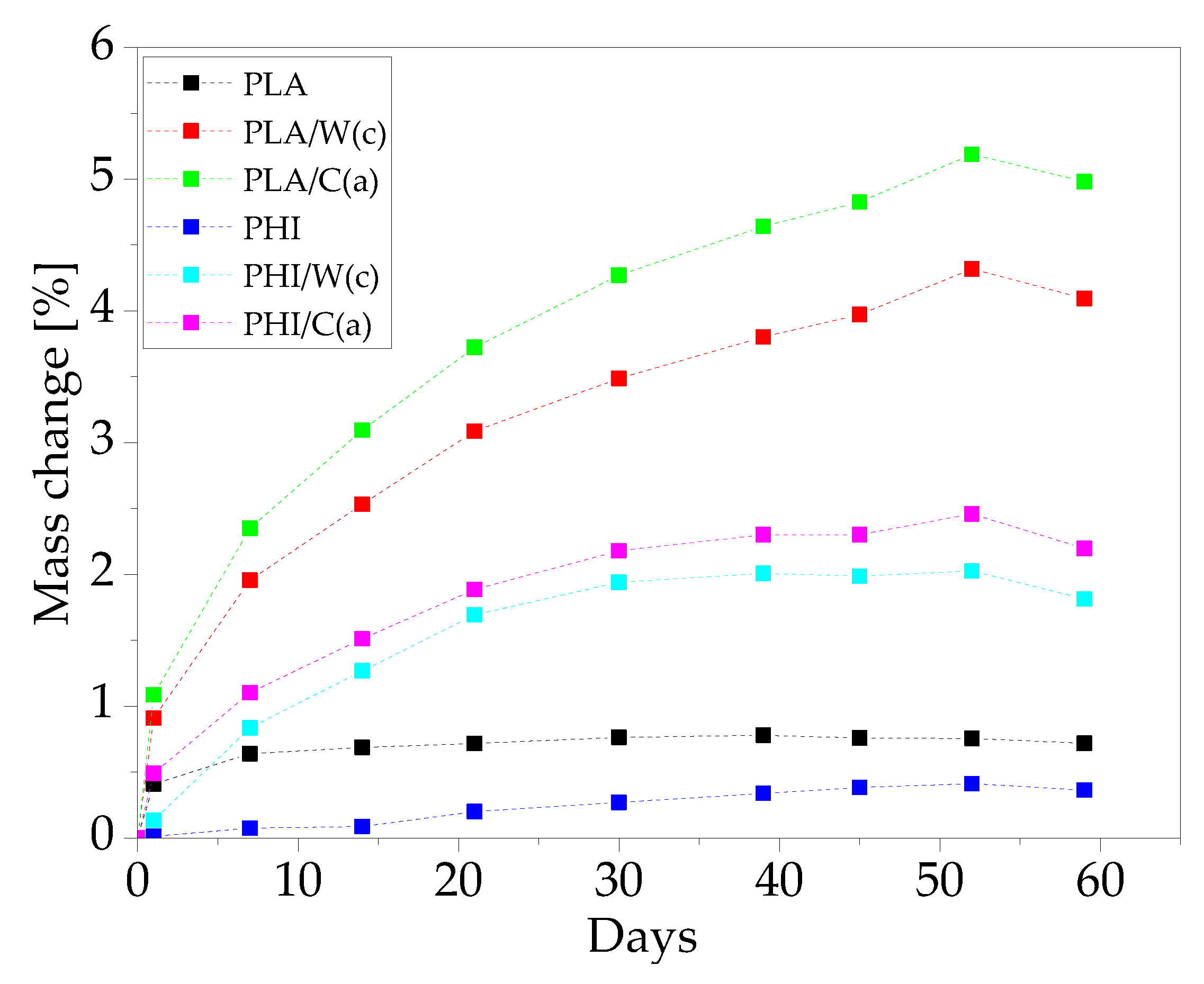
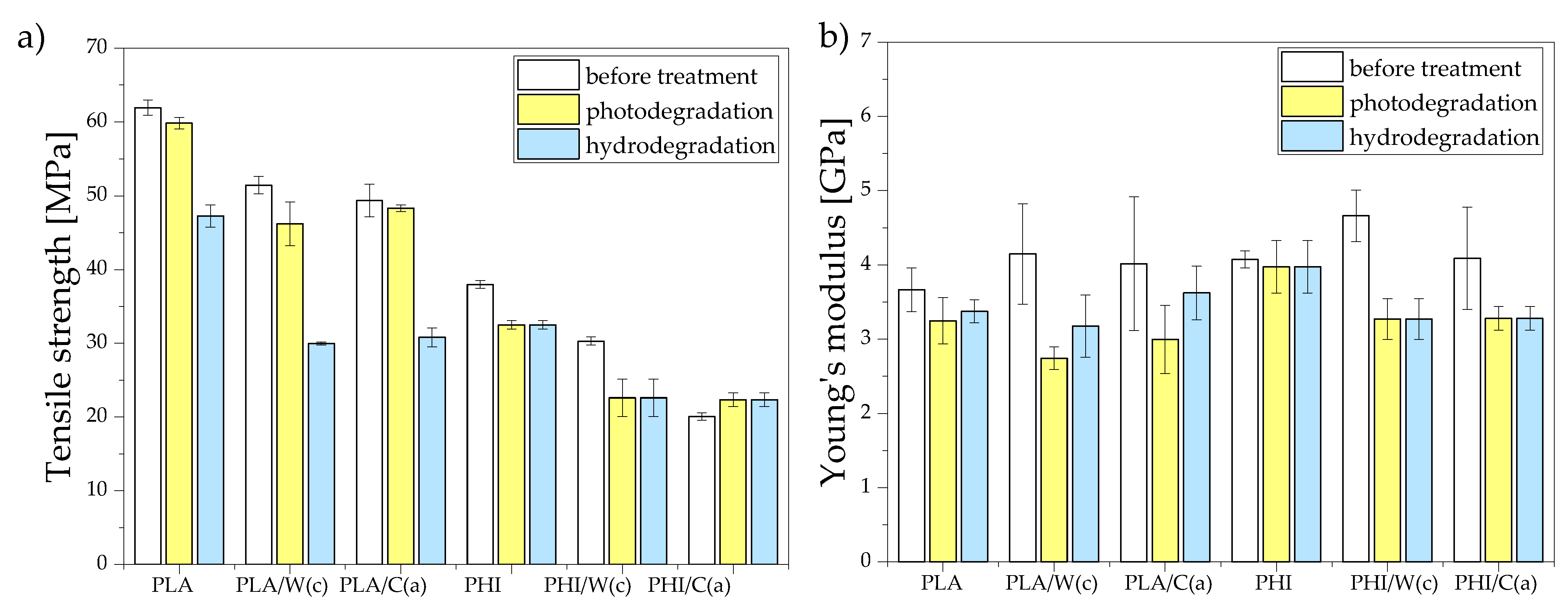
| Properties | Polylactide (PLI005) | Polyhydroxyalcanoates (PHI 003) |
|---|---|---|
| Density (g/cm3) | 1.25 | 1.24 |
| Fluidity index (g/10 min) 190 °C/2.16 kg | 25–35 | 15–30 |
| Tensile modulus (MPa) | 3,500 | 4,200 |
| Tensile elongation at break (%) | 4 | 4 |
| Charpy impact test, without notch (kJ/m2) | 22 | 5 |
| Thermal resistance (°C) (HDT B) | 53 | 134 |
| Index | Compositions |
|---|---|
| PLA | 100% Polylactide |
| PLA/W(c) | Polylactide + 10 wt% walnut shell flour + 2 wt% carotene |
| PLA/C(a) | Polylactide + 10 wt% cellulose + 2 wt% anthocyanin |
| PHI | 100% Polyhydroxyalcanoates |
| PHI/W(c) | Polyhydroxyalcanoates + 10 wt% walnut shell flour + 2 wt% carotene |
| PHI/C(a) | Polyhydroxyalcanoates + 10 wt% cellulose + 2 wt% anthocyanin |
| Samples | Tensile Strength [MPa] | Young’s Modulus [GPa] | Flexural Strength [MPa] | Flexural Modulus [GPa] |
|---|---|---|---|---|
| PLA | 62.0 ± 1.1 | 3.7 ± 0.3 | 102.8 ± 3.1 | 3.7 ± 0.1 |
| PLA/W(c) | 51.5 ± 1.2 | 4.2 ± 0.7 | 87.7 ± 3.9 | 3.9 ± 0.1 |
| PLA/C(a) | 49.4 ± 2.2 | 4.0 ± 0.9 | 83.7 ± 4.0 | 4.0 ± 0.2 |
| PHI | 38.0 ± 0.5 | 4.1 ± 0.1 | 68.9 ± 2.9 | 3.5 ± 0.2 |
| PHI/W(c) | 30.3 ± 0.6 | 4.7 ± 0.4 | 56.5 ± 1.5 | 3.8 ± 0.1 |
| PHI/C(a) | 20.1 ± 0.5 | 4.1 ± 0.7 | 57.0 ± 2.0 | 4.5 ± 0.3 |
| Samples | Dissipation Energy (mJ) | Maximum Force (kN) | Number of Cycles |
|---|---|---|---|
| PLA | 2.4 | 0.72 | 13,617 |
| PLA/W(c) | 2.1 | 0.72 | 11,907 |
| PLA/C(a) | 4.0 | 0.81 | 17,409 |
| PHI | 7.5 | 0.68 * | 60,000 |
| PHI/W(c) | 5.1 | 0.64 | 50,191 |
| PHI/C(a) | 5.6 | 0.68 * | 55,036 |
| Samples | After Photodegradation | After Hydrodegradation |
|---|---|---|
| PLA | 0.85 | 3.64 |
| PLA/W(c) | 7.86 | 10.63 |
| PLA/C(a) | 10.92 | 30.50 |
| PHI | 7.33 | 2.06 |
| PHI/W(c) | 36.60 | 24.02 |
| PHI/C(a) | 15.02 | 13.29 |
Publisher’s Note: MDPI stays neutral with regard to jurisdictional claims in published maps and institutional affiliations. |
© 2022 by the authors. Licensee MDPI, Basel, Switzerland. This article is an open access article distributed under the terms and conditions of the Creative Commons Attribution (CC BY) license (https://creativecommons.org/licenses/by/4.0/).
Share and Cite
Mazur, K.E.; Bazan, P.; Liber-Kneć, A.; Stępień, J.; Puckowski, A.; Mirowski, A.; Kuciel, S. Analysis of the Effect of Photo and Hydrodegradation on the Surface Morphology and Mechanical Properties of Composites Based on PLA and PHI Modified with Natural Particles. Materials 2022, 15, 878. https://doi.org/10.3390/ma15030878
Mazur KE, Bazan P, Liber-Kneć A, Stępień J, Puckowski A, Mirowski A, Kuciel S. Analysis of the Effect of Photo and Hydrodegradation on the Surface Morphology and Mechanical Properties of Composites Based on PLA and PHI Modified with Natural Particles. Materials. 2022; 15(3):878. https://doi.org/10.3390/ma15030878
Chicago/Turabian StyleMazur, Karolina E., Patrycja Bazan, Aneta Liber-Kneć, Julia Stępień, Alan Puckowski, Adrian Mirowski, and Stanisław Kuciel. 2022. "Analysis of the Effect of Photo and Hydrodegradation on the Surface Morphology and Mechanical Properties of Composites Based on PLA and PHI Modified with Natural Particles" Materials 15, no. 3: 878. https://doi.org/10.3390/ma15030878
APA StyleMazur, K. E., Bazan, P., Liber-Kneć, A., Stępień, J., Puckowski, A., Mirowski, A., & Kuciel, S. (2022). Analysis of the Effect of Photo and Hydrodegradation on the Surface Morphology and Mechanical Properties of Composites Based on PLA and PHI Modified with Natural Particles. Materials, 15(3), 878. https://doi.org/10.3390/ma15030878







